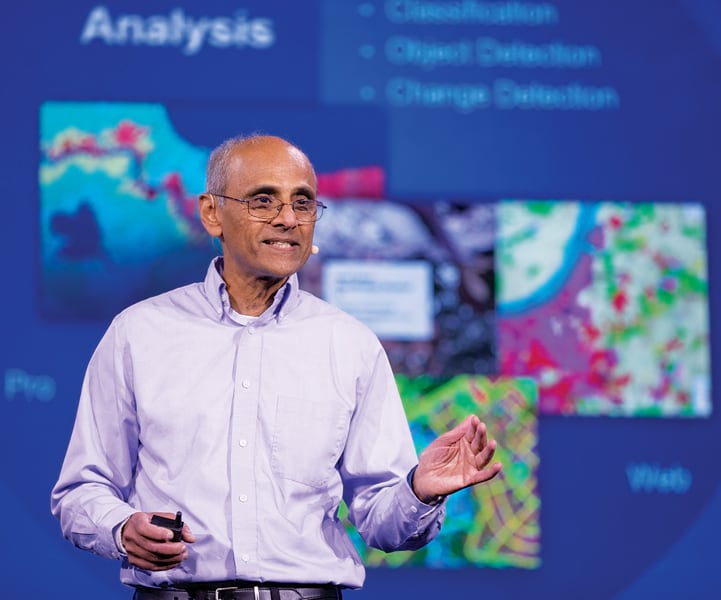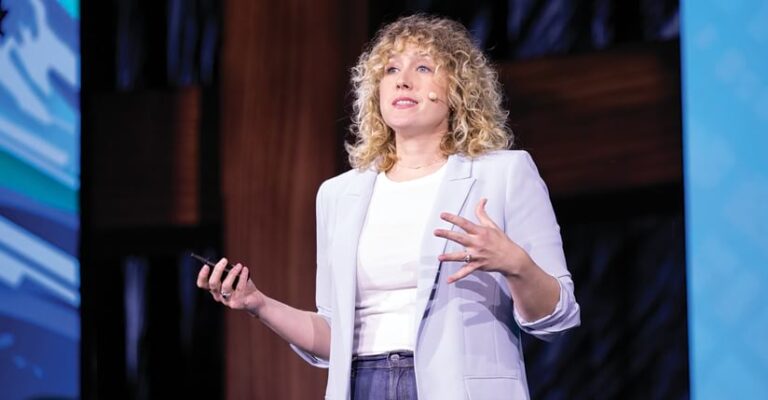It’s nice to be back, isn’t it?” Esri president Jack Dangermond asked the audience when he opened the 2022 Esri Developer Summit (DevSummit), held in Palm Springs, California, for the first time in two years.
“There is a lot of energy in this room,” echoed Esri product manager for developer technology David Cardella, who served as emcee for most of the Plenary Session.

More than 1,000 attendees from dozens of countries took part in the 17th DevSummit, gathering March 8–11, 2022, at the Palm Springs Convention Center. Extra health and safety precautions were put in place due to the ongoing COVID-19 pandemic, and the event offered several virtual components.
But it was evident from the outset that the most thrilling part of DevSummit was having developers and Esri staff members together again in the same room.
“This is a time where you can get together and meet each other and inspire each other,” said Dangermond, minutes before Cardella expressed Esri’s appreciation for the developer community.
“You engage us. You provide us with feedback so we can improve our products. You push our technologies to the limit. And you challenge us to do more and to do better,” Cardella said. “We’ve got hundreds of Esri staff from the development teams and the product teams who are eager to interact with all of you.”
While geospatial technologies have a rich history and developers have been helping to advance them for decades, Dangermond noted that this field is really just getting started.
“It’s a field that’s going to address basically all the major challenges and all the major problems that we are facing as a society,” he said. “This is where developers really come in, because it’s your creativity, your craft, your work, and your understanding of what is needed and wanted that really make it come alive.”
Over the last few years, Esri has completely rearchitected its developer technology.
“We’ve done this to stay modern and current, yes,” Cardella said. “But we’ve also done it so we can provide sophisticated capabilities that you can then use and implement in your solutions.”
The ensuing plenary presentations, which took place over three days, were divided into three overarching themes: building applications, the ArcGIS system, and extending ArcGIS and spatial analytics. More than 50 Esri developers and product experts showcased the recent enhancements that have been made to ArcGIS developer technology. By the end, what emerged was a picture of a comprehensive developer experience that gives developers the tools they need to create stunning, innovative, and engaging geospatial products.
Improvements to Web and Native App Development
In a whirlwind of demonstrations that rounded out day one of the Plenary Session, DevSummit attendees were introduced to the latest enhancements in Esri’s web and native app development systems.

Product manager Jianxia Song showed how ArcGIS Experience Builder makes it easy to build custom web apps without writing a single line of code. Members of the ArcGIS API for JavaScript team then presented an array of updates that enable web apps to produce impressive visualizations much more quickly. In addition to being able to render big data faster and at more detailed scales than before, JavaScript API now supports client-side queries, which makes it less taxing on the server for apps to go viral.
To help developers produce stylish and consistent-looking mapping apps, Esri released its Calcite Design System last year—and continues to make improvements to it, as Julie Powell, principal product manager for JavaScript API and Calcite, explained to the audience. It is the same design system that Esri developers use, and it has a rich library of user interface components, such as buttons, icons, and theme colors.
“[You] can create clean, consistent, and modern user experiences with minimal effort,” Powell said.
For building high-performance native mapping apps, ArcGIS Runtime SDKs have what developers need.

“Whether you’re building apps for the office or apps for the field, apps for consumers or apps for the enterprise, ArcGIS Runtime can put the right map in the right app on the right device,” said Divesh Goyal, product lead for the ArcGIS Runtime SDK for .NET team.
Over the past year, the ArcGIS Runtime team has added support for multiscale maps so they show the right details at the right time. Display filters have been added to allow users to explore maps while focusing on the right data. The team has improved the performance of scene layers and labeling in 3D. And it is now possible to render vector tiles in 3D.
One new development that takes location-based native apps to the next level, according to Goyal, is geotriggers.
“Geotriggers allow you, as developers, to automate workflows in your apps based on the user’s location,” he said.
Geotriggers can be used to open forms for users to fill out when they arrive at certain locations or to turn layers on and off. And all this works offline.
The first day’s Plenary Session ended with impressive demonstrations from early adopters of ArcGIS Maps SDK for game engines, which brings scenes to life in augmented and virtual reality. This capability is becoming more in demand in industries that range from defense and public safety to natural resources.
A Tour of the ArcGIS System
For day two of the Plenary Session, Dr. Sud Menon, Esri’s director of software product development, guided the audience through a comprehensive overview of the ArcGIS system.

“ArcGIS is advancing rapidly in all its capabilities, integrating and leveraging many innovations from the larger worlds of computing and science,” he said.
Menon noted that Esri’s goal is to have ArcGIS support a multitude of communities, from the GIS and mapping communities to developers and data scientists.
ArcGIS Platform, Esri’s platform as a service (PaaS) offering, is specifically geared toward developers who want to embed mapping and location services in their apps.
“Those services are the foundation of things like basemaps, geocoding, geoenrichment, and routing, all the way up to spatial analysis and the hosting of your own data,” Menon explained. “And it comes with a very simple and clean consumption-based business model.”
A host of product engineers, product managers, and software developers then showed attendees new capabilities in Map Viewer and ArcGIS Arcade, improvements to products such as ArcGIS Insights and ArcGIS Image for ArcGIS Online, new offerings including ArcGIS Knowledge and ArcGIS Velocity, and new ways to access cloud-based data and do spatial analysis.
For people who would like to perform spatial analysis without having to load their data into a SQL-based data warehouse, ArcGIS GeoAnalytics On Demand Engine offers a solution. Leveraging the Apache Spark unified analytics engine, it is a stand-alone spatial analytics system for processing massive volumes of data, and it works with all kinds of files. It relies on a consumption-based model and is expected to be out of beta this summer.
The integration of ArcGIS Utility Network with ArcGIS Field Maps was also a big topic of the day. Brent Pierce, product engineering lead for Field Maps, used an example from the Dubai Electricity and Water Authority to show how mobile workers can access key detailed utility network data in the field. (For more on this, see “Esri’s Field Maps App Is Helping Meet the Needs of the Modern Mobile Workforce.”)

How to Extend ArcGIS and Expand Spatial Analytics
The third and final day of the Plenary Session got into the details of how developers can extend ArcGIS technology and expand its spatial analytics capabilities.
Esri’s chief technology officer (CTO), Jim McKinney, noted that there are two ways for developers to extend ArcGIS Pro: with Python and with ArcGIS Runtime SDK for .NET. Developers can use these to build ArcGIS Pro add-ins, like new tools and customized workflows; create custom configurations; integrate proprietary datasets with ArcGIS Pro; and develop stand-alone apps on top of the ArcGIS Pro geodatabase.
ArcGIS is also an enterprise-ready automation platform, as Jay Theodore, Esri’s CTO of ArcGIS Enterprise and artificial intelligence (AI), explained.
“Over the last year, we’ve added a lot of functionality in terms of GIS workflow automation,” he said, specifying that developers can automate workflows, operations, and collaborations. “You can automate all these things through the API, but you can also do it through low-code and no-code options.”
At the core of the ArcGIS system is spatial data science, as Dr. Lauren Bennett, program manager for spatial analysis and data science at Esri, made clear.

“It’s not about algorithms for algorithms’ sake and technology for technology’s sake,” she said. “It’s really about applying that geographic approach to solve the complex challenges that our organizations, our communities, and the world face.”
Esri is advancing spatial data science in a number of ways, she said, including via spatiotemporal statistics, multidimensional raster analysis, and geospatial AI. For example, new tools in ArcGIS can predict the presence of events without having absence data and detect change points across time. These tools can help forecast where wildfires might happen and dig deeper into how the pandemic has affected small business startups.
At the end of almost every presentation, the product engineers featured in this last section of the Plenary Session concluded with fitting parting words: “We can’t wait to see what you do with all this.”

